GALLERY OF LEGUMINOLOGISTS
This year the Gallery of Leguminologists features a papilionoid specialist and, once again, mimosoid specialists.
The editors of Bean Bag would welcome photos and reminiscences about researchers from other areas of legume taxonomy and biology, especially for those who may be less well known to the current generation of the legume community, and leguminologists whose achievements have not always been celebrated elsewhere.
Synopses need not be complete biographies but a few images would bring them to life.
David S. Seigler & John E. Ebinger
Helen C.F. Hopkins (Royal Botanic Gardens Kew, UK) & Bruce R. Maslin (Bentley Delivery Centre, Australia)
To mark the recent publication of “Names for American Acacia (Fabaceae: Mimosoideae)”, we are highlighting the careers of David S. Seigler (1940–) and John E. Ebinger (1933–). Both are currently emeritus professors at the University of Illinois, Urbana, and Eastern Illinois University, Charleston, respectively. They are the authors of numerous new species and new combinations in Vachellia and Senegalia, as well as in their new genera Mariosousa, Parasenegalia, and Pseudosenegalia, all segregates of Acacia s.l. in the Americas. The nomenclator, co-authored with Joseph Miller and Victoria Hollowell, pulls together a huge amount of information, and the authors have made a considerable effort to establish the correct application of names. It represents a tremendous achievement that will have a lasting impact, especially for American mimosoid taxonomy and nomenclature. They account for more than 1700 species names and 239 infraspecific ones that together refer to 386 accepted taxa; almost 250 lectotypes and a few neotypes are also designated.
Dave continues to have a remarkable dual career as a plant taxonomist and phytochemist. This second interest came first, and in this field, he has published on a variety of groups (e.g., Passiflora, Ungnadia, Euphorbiaceae), especially on cyanogenic glycosides. He has written a textbook on plant secondary metabolism and edited or co-edited symposium volumes on plant chemistry and crop plants. His office is said to be piled high with books and reprints. He did a lot of collecting, including of acacias, while a postdoc at the University of Texas, but he didn’t follow up on this until he was based in Illinois and worked over several summers in the lab of Dr. Eric E. Conn at the University of California, Davis. Eric (or Dr. Caaan as Dave would call him) was a renowned biochemist who found that different biochemical pathways to cyanogenesis are characteristic of different taxonomic groups within Acacia s.l. Dave’s interest in acacia taxonomy started from cyanogenesis, and he has done fieldwork and research in Mexico, South America, and Western Australia. During a field trip in the southern USA in 2022, he was bitten by a rattlesnake, ended up in intensive care for six days, but undaunted, was soon back at work as usual.
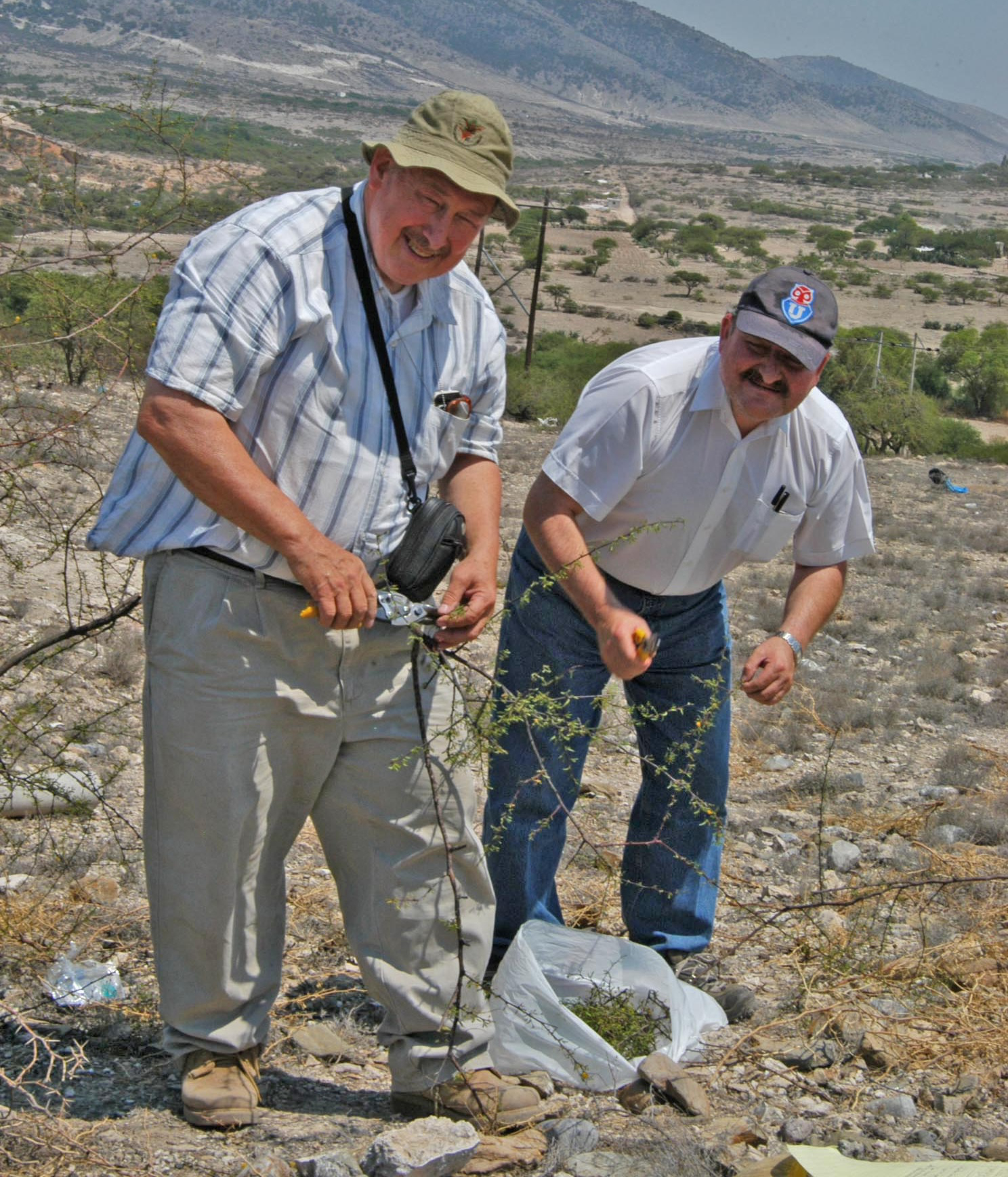 Dave Seigler & Carlos Cespedes, 5 km NE of Vizarron on road to Jalpan, Mexico, 10 June 2005.
Dave Seigler & Carlos Cespedes, 5 km NE of Vizarron on road to Jalpan, Mexico, 10 June 2005.
After a BA in botany from Miami University, Oxford, Ohio, and a spell in the US Air Force as a jet and helicopter pilot, John completed his MSc and PhD at Yale. Apparently, he flew one of the jets from Florida to New Haven for his interview. He subsequently became a professor of Botany at Eastern Illinois University, a position he held from 1963 until his formal retirement in 1995. His early taxonomic work included studies on Kalmia (Ericaceae) and Luzula (Juncaceae), and in this family, he is commemorated by the genus Ebingeria. He has written or co-authored over 200 papers, many on the vegetation, flora, and rare plants of Illinois and the Midwest. At Eastern Illinois University, the Stover-Ebinger herbarium (EIC) is named (half) in his honor. His current interests include nomenclature and old literature, and he has an excellent editorial eye, alongside an exuberant personality. Comments on manuscripts are sometimes emphasized by long lines of exclamation and question marks, and “check” in capital letters.
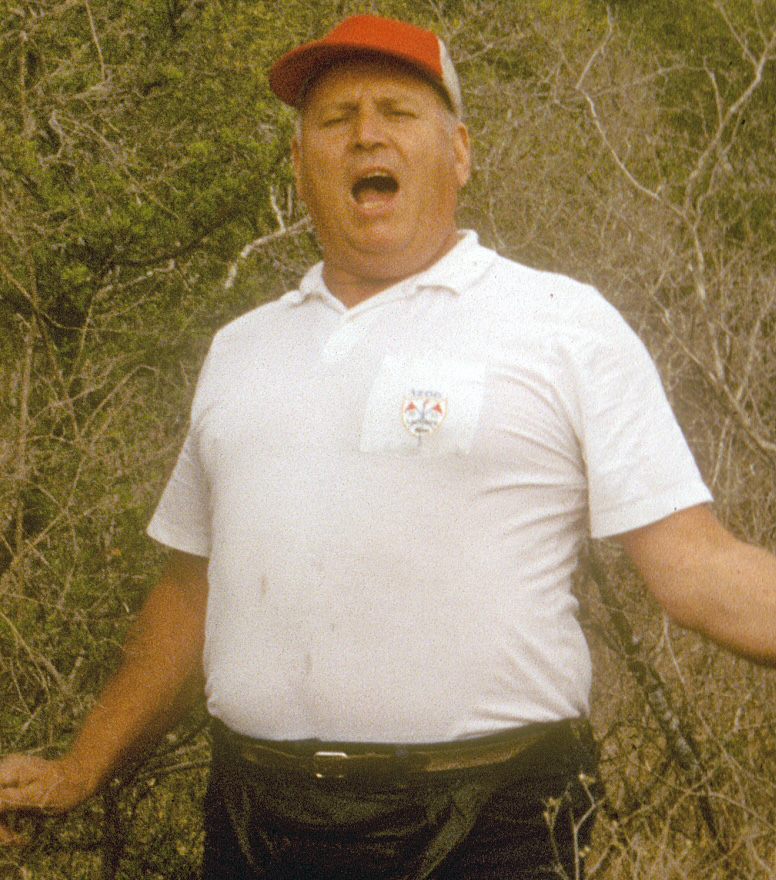 John Ebinger, bursts into song in a pasture full of Vachellia farnesiana in Mexico. Photo: Dave Seigler.
John Ebinger, bursts into song in a pasture full of Vachellia farnesiana in Mexico. Photo: Dave Seigler.
The pair first met in the early 1970s through the Illinois State Academy of Science, and by the early 1980s, they had started collaborating on acacias, becoming increasingly interested in their taxonomy. They undertook several field trips, especially to Mexico and Texas, with John also visiting Curacao and Florida. Although they have frequently worked with other people (e.g., Céspedes et al. 2013; Ebinger et al. 2010), most of their taxonomic publications on mimosoids have been written together, including accounts in ALS 14-2.
Dave and John have the same sense of humor, and there is a great synergy between them, as they pass manuscripts back and forth, debating and checking. No longer in their first flush of youth, John is now 91 and has recently undergone heart surgery, and Dave is a few years behind in age with a touch of arthritis. But their work is far from done. They have an account of Vachellia in the Americas almost ready for the press, and a treatment for Senegalia is not far behind.
The following reminiscences from Bruce Maslin refer principally to two field trips to Mexico with Dave:
I first met Dave in 1985 when we were both visiting Eric Conn’s laboratory at Davis. The following year we met again, this time in the company of John, at the Second International Legume Conference in St. Louis. After this conference, DSS and I started out on our first trip to Mexico, traveling in his pickup to the border at Laredo. We did a little general mimosoid collecting in Oklahoma on the way, and in Texas, Dave introduced me to my first American acacias, now species of Vachellia and Senegalia.
From Laredo, we took a bus to Monterrey, where we picked up a hired VW beetle. To my horror, Dave said I could drive — I had never driven on the “wrong side” of the road before, and what an experience that was, especially on Mexican roads! I won’t detail the very many wonderful experiences from our journey to Oaxaca in the south, but suffice it to say that Dave’s congenial personality, sense of humor, broad knowledge of plants, Mexican geography and history, and of course his familiarity with mimosoids, all contributed to making this a truly memorable trip.
All up, we were on the road for almost two weeks. Two decades later, we returned to Mexico, this time reaching the northern tip of the Yucatan Peninsula. Many of the photos that were taken on these trips are now on the WorldWideWattle website as species of Acaciella, Mariosousa, Senegalia, and Vachellia. If I had to choose a Mexican species that amazed me the most, then it would have to be one of the remarkable Ant Acacias, Vachellia cornigera, with its incredible stipular spines inhabited by ants (until disturbed!), large petiole glands, which provide ants with a source of carbohydrate, and leaflet tips that possess specialized protein “sausages” called Beltian Bodies, which the ants also harvest. In return, the ants are aggressive defenders of the plants that they call home.
Selected references
Céspedes, C. L., Sampietro, D. A., Seigler, D. S. & Rai, M. (eds) (2013). Natural antioxidants and biocides from wild medicinal plants. CABI.
Ebinger, J. E., Phillippe, L. R., Murphy, M. J., Tucker, G. C. & Marcum, P. (2010). Vascular plant species extirpated or not vouchered as occurring in Illinois. Erigenia: Journal of the Southern Illinois Native Plant Society 23: 3–23.
Seigler, D. S. & Conn, E. E. (1982). Cyanogenesis and systematics of the genus Acacia. Bulletin of the International Group for the Study of Mimosoideae 10: 32–43.
Seigler, D. S. & Ebinger, J. E. (1987). Cyanogenic glycosides in ant-acacias of Mexico and Central America. The Southwestern Naturalist 32(4): 499–503.
Seigler, D. S., Ebinger, J. E., Hollowell, V. C. & Riggins, C. W. (2023). Revision of the genus Mariosousa (Fabaceae, Mimosoideae) in the New World. Phytologia 105(2): 29–67.
Seigler, D. S. (1998). Plant Secondary Metabolism. Kluwer Academic, Boston & London.
Seigler, D. S., Ebinger, J. E., Miller, J. T. & Hollowell, V. C. (2024). Names for American Acacia (Fabaceae, Mimosoideae). – Sida, Bot. Misc. 65. Fort Worth Bot. Gard., Texas: BRIT Press. https://shopbritpress.org/products/names-for-american-acacia-fabaceae-mimosoideae.
Ivan Christian Nielsen (1946–2007)
Colin Hughes (University of Zurich, Switzerland), Daniel Murphy (Royal Botanic Gardens Victoria, Australia) & Bente Klitgaard (Royal Botanic Gardens Kew, UK)
The Danish botanist Ivan Nielsen was an expert on mimosoid legumes of S.E. Asia. Between 1976 and 1992, Ivan produced an impressive series of publications on the taxonomy of Asian mimosoids. These included numerous national and regional flora treatments of mimosoids (Cambodia, Laos & Vietnam; New Caledonia; Thailand; Malesiana), revisions of the ingoid genera Archidendropsis, Wallaceodendron, Paraserianthes, Pararchidendron, and Serianthes in the Malesian, Australian, and Pacific region (together with P. Guinet and T. Baretta-Kuipers; 1983-1984 in Adansonia), revisions of the large, complex, and species-rich genus Archidendron (Opera Botanica, 1985), and the Malesian species of Acacia and Albizia (Opera Botanica, 1985). All of this culminated in his comprehensive regional treatment of mimosoid legumes for Flora Malesiana in 1992. Underpinning all this, Ivan carried out extensive fieldwork in S.E. Asia, making invaluable collections of poorly-known mimosoids.

Ivan Nielsen in 1978 at the first meeting of the International Group for Study of Mimosoideae, IGSM, Kew, London. Photo: Bruce Maslin.
In many ways, Ivan Nielsen was to S.E. Asian mimosoid legumes what Rupert Barneby was to Neotropical mimosoids. They both provided important advances in the generic classification of the pantropical, species-rich ingoid clade (former tribe Ingeae plus Acacia), as well as substantial species-level taxonomic accounts of ingoid legume genera in their respective geographical regions. At the same time, they were both acutely aware that generic delimitation across tribe Ingeae would require further pantropical synthesis, as well as improved phylogenies that would come from the goldmine of new DNA sequence data starting to emerge in the early 2000s. To advance this, Ivan invited one of us (DM) to work on molecular phylogenetics of Ingeae with him in Aarhus, but unfortunately, the full results of this collaboration did not come to fruition before Ivan became ill. Nevertheless, the critical foundations established by Ivan and Rupert Barneby paved the way for the more integrated world view of the ingoid clade that has recently been achieved through molecular phylogenies sampling pantropically.
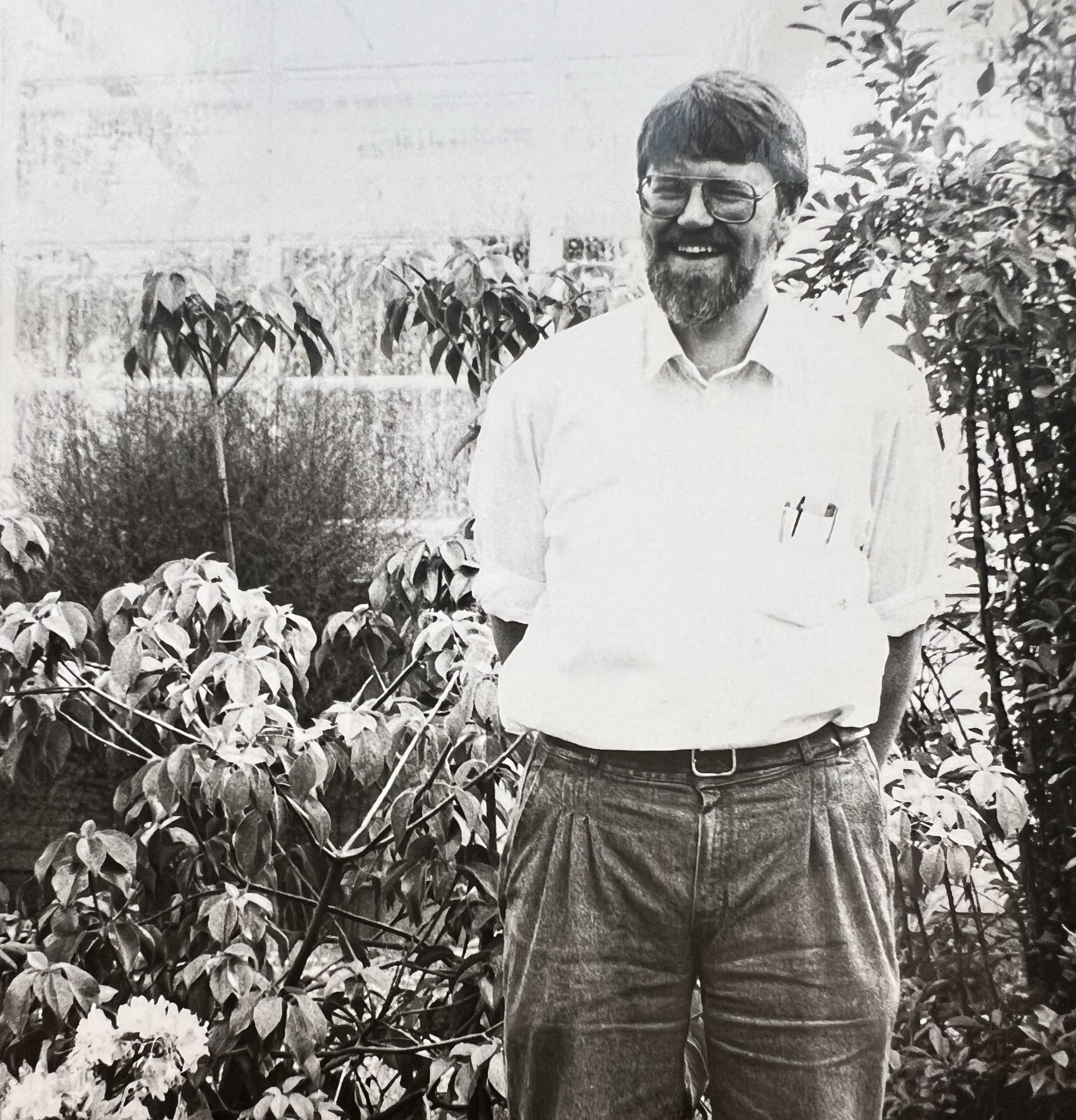 Ivan in the greenhouses of the botanic garden in Aarhus, photo Aarhus Stiftstidende.
Ivan in the greenhouses of the botanic garden in Aarhus, photo Aarhus Stiftstidende.
Ivan Nielsen studied and worked almost throughout his career at the Department of Systematic Botany and the Institute of Biology at Aarhus University in Denmark, initially as an undergraduate, Master’s, and Doctoral student and later as assistant professor, lecturer, senior research fellow, curator of the Herbarium Jutlandicum (AAU), and finally as director of the Institute (1985-1992). Ivan was thus heavily involved in administration, but his deep love of botany and plants was always to the fore, notably in the flair and knowledge he brought as manager of the greenhouses in the botanic garden in Aarhus. Ivan was an important contributor to the establishment, expansion, success, and world-class reputation of botany in Aarhus.
 Ivan at a reception in the Institute for Botany, University of Aarhus, photographer unknown.
Ivan at a reception in the Institute for Botany, University of Aarhus, photographer unknown.
Ivan had many other roles, notably as Editor of the Nordic Journal of Botany and Opera Botanica from 2001 to 2006. Furthermore, Ivan was deeply committed to supporting capacity building and training, work that took him to Africa and especially Senegal and Burkina Faso, funded by the Danish International Development Agency, DANIDA. This work led to his appointment as a member (1993-1996) and later chairman (1996-2001) of the Danish Council for Development Research and as a board member of the International Plant Genetic Resources Institute in Rome.
Ivan lived with his wife on a farmstead in a beautiful spot in central Jutland, Denmark. He was a proud Dane committed to the rural environment; a true gentleman of the old school of taxonomic botanists; a mentor to students and younger colleagues, and he had a calm, careful, kind, and welcoming demeanor and a committed and optimistic outlook. His premature death at age 61 left a big gap in both Aarhus and the legume community.
References
Friis I. 2008. In Memoriam: Editor-in-Chief of Nordic Journal of Botany Ivan Nielsen, 18 February 1946 - 1 December 2007. Nordic Journal of Botany 25: 381-382.
Øllgaard B. 2008. Nekrologer. Ivan Christian Nielsen. Aarhus University, Universitetshistorie.
Velva E. Rudd (1910–1999)
Colin Hughes (University of Zurich, Switzerland) & Toby Pennington (University of Exeter, UK)
Like so many botanists, Velva Rudd developed a lifelong interest in a particular plant group—in her case, the legumes—during her PhD, which focused on the American species of Aeschynomene (Papilionoideae). Velva worked primarily on tropical American papilionoid legumes, publishing more than 70 taxonomic papers. These included a six-part monograph in Contributions from the United States National Herbarium, published over a thirteen-year period (1955–1968), comprising species-level taxonomic accounts of seven genera (Aeschynomene, Ateleia, Chaetocalyx, Cyathostegia, Dussia, Nissolia, and Ormosia) in the Americas.
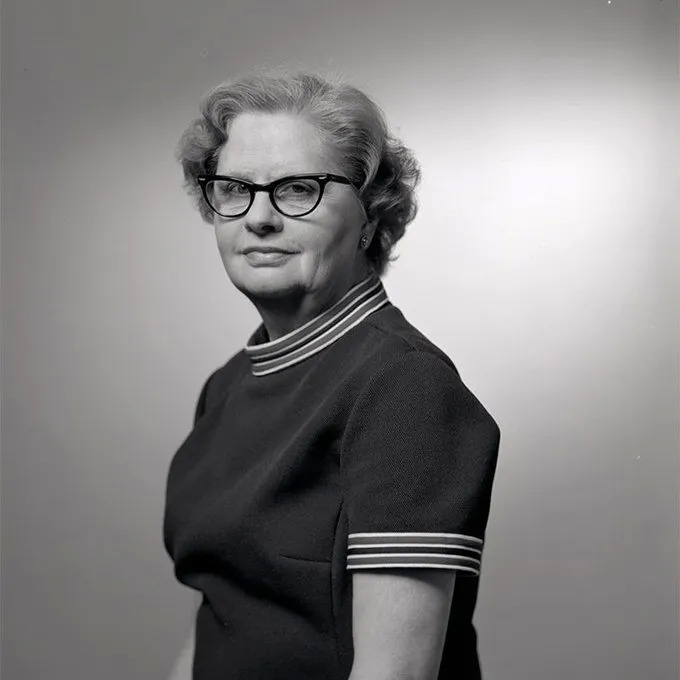
Velva Rudd in 1973, Directory of Scientists in the National Museum of Natural History, photo courtesy of Smithsonian Department of Botany
Working before the advent of molecular phylogenetics, Velva relied on morphology, leaving her with several generic delimitation and classificatory dilemmas that she puzzled over. Based on her accounts, many of these questions have now been resolved (e.g., the non-monophyly of Aeschynomene), but it is striking how many of the groups she recognized correspond to clades. Though she worked with limited numbers of herbarium specimens in her revisions of neotropical groups, more recent work that has benefited from much more extensive collections made through the 1970s–2000s has often shown Velva’s species boundaries to be sound (e.g., in Centrolobium and Dussia). This accuracy of species delimitation speaks to an excellent taxonomic eye and the ability to be pragmatic and productive in the face of incomplete data.
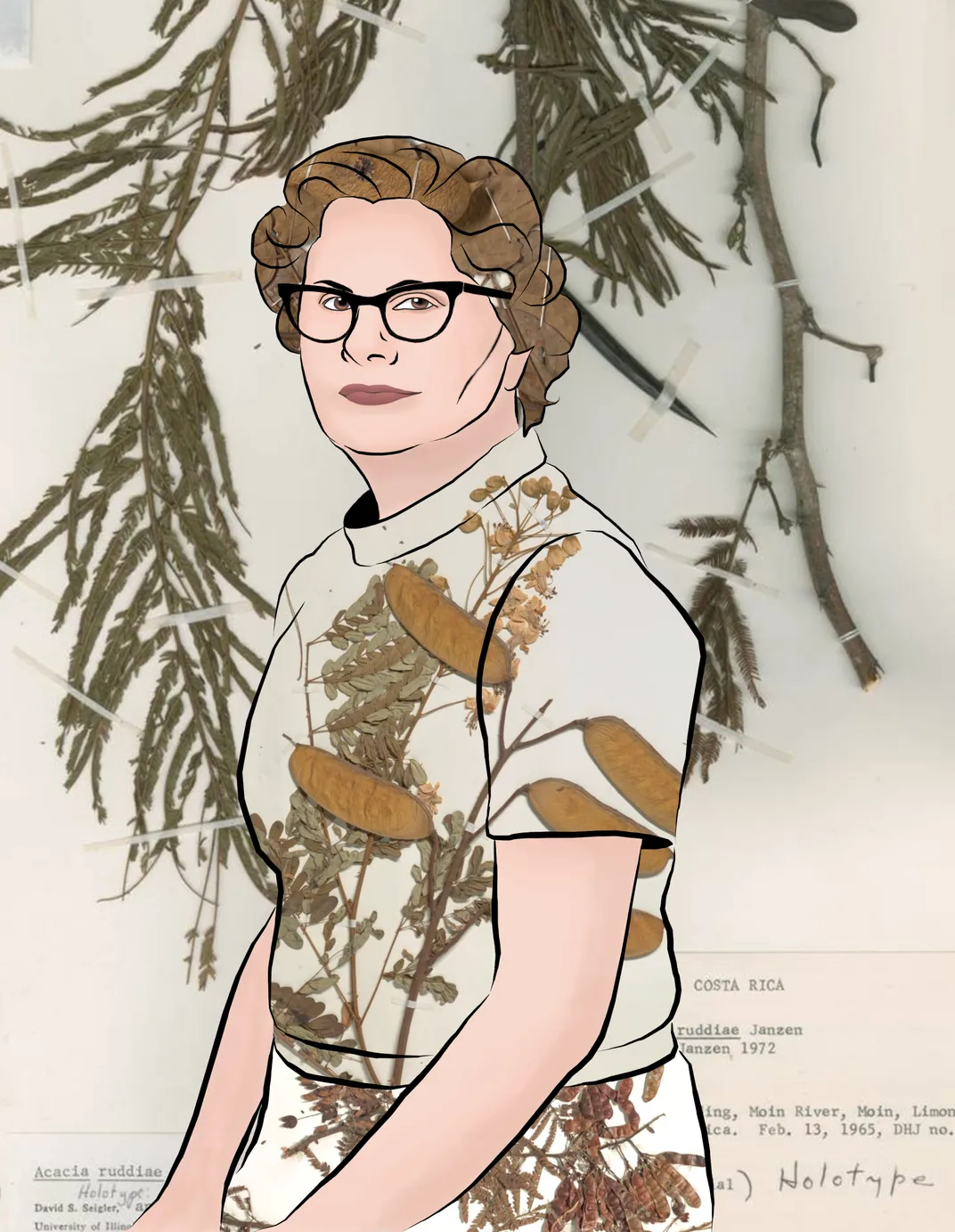 Portrait of Velva Rudd, from Torres, A. 2019. Get to Know the Leading Ladies of Science at the Smithsonian. Smithsonian Voices. National Museum of Natural History.
Portrait of Velva Rudd, from Torres, A. 2019. Get to Know the Leading Ladies of Science at the Smithsonian. Smithsonian Voices. National Museum of Natural History.
Like many of the most productive taxonomic specialists, Velva Rudd worked throughout her career in one place—at the Smithsonian National Museum of Natural History Department of Botany in the U.S. National Herbarium. As one of a small group of pioneering female scientists working at the Smithsonian, Velva played a part in paving the way for greater gender equality in botany and indeed more widely. She started as a technician, becoming assistant curator in 1948, and later curator until her retirement in 1973. As a curator embedded in a large herbarium with rich legume collections, Velva’s work spanned large swathes of the legume family alongside the core genera she worked most intensively on.
She published 156 names across legumes, including in the genera Acacia (now in Vachellia), Aeschynomene, Centrolobium, Cladastris, Coursetia, Crotalaria, Dalbergia, Desmanthus, Dussia, Machaerium, Mimosa, Myrocarpus, Nissolia, Ormosia, Oxyrhynchus, Paramachaerium, Piscidia, Poecilanthe, Poiretia, Sophora, and Styphnolobium. Before her death in 1999, she submitted several generic treatments for the recently published legume volume of the Flora of North America.
Having wrapped up an illustrious career at the Smithsonian, Velva moved to California and, in semi-retirement, continued to be active in botany, associated with a tiny herbarium at California State University, Northridge (SFV). Velva was a seasoned traveler, did fieldwork in Brazil, Costa Rica, Mexico, Sri Lanka, and Venezuela, and was still traveling well into her 80s, touring Costa Rica.
A suite of legumes are named in her honor, including the genus Ruddia Yakovlev (1971) (now a synonym in Ormosia), subgenus Ruddia of Ateleia, Ormosia ruddiana, Acacia ruddiae (now Vachellia), Dioclea ruddiae (now Macropsychanthus), and Nissolia ruddiae.
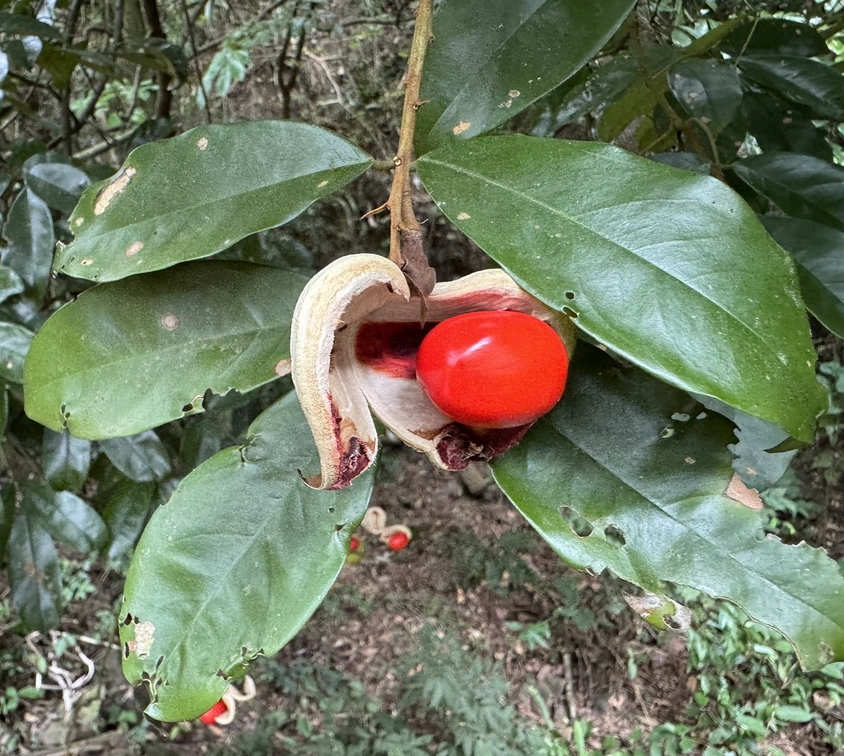 Ormosia fordiana, formerly Ruddia fordiana (Oliv.) Yakovlev © luotuo
Ormosia fordiana, formerly Ruddia fordiana (Oliv.) Yakovlev © luotuo